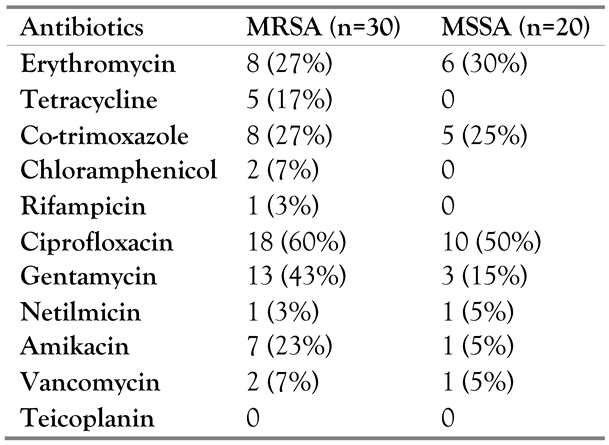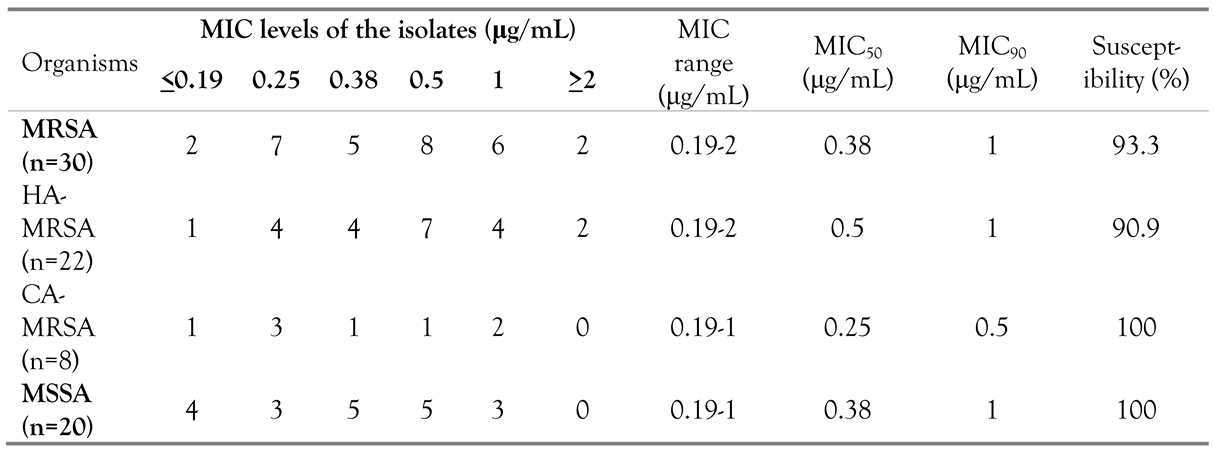Daptomycin Resistance in Methicillin-Resistant Staphylococcus aureus: A Report from Southern India
Author Contributions
Conflicts of Interest
References
- Mathai, D.; Biedenbach, D.J.; Jones, R.N.; et al. Activity of daptomycin against gram-positive bacterial isolates from Indian medical centres (2006–2007). Int J Antimicrob Agents. 2009, 34, 497–499. [Google Scholar] [CrossRef] [PubMed]
- Behera, B.; Jain, N.; Sharma, S.; Mathur, P.; Misra, M.C. Antimicrobial activity of daptomycin against Staphylococcus aureus isolates from skin and skin structure infections of trauma patients. J Infect. 2010, 61, 195–196. [Google Scholar] [CrossRef] [PubMed]
- Rajya Sabha, P.o.I. Department-related parliamentary standing committee on health and family welfare: Fifty-ninth report on the functioning of the central drugs standard control organisation (cdsco). Welfare HaF, New Delhi, 2012.
- D’Souza, N.; Shetty, A.; Mehta, A.; Rodrigues, C. Antimicrobial susceptibility profiles of meticillin-susceptible and -resistant Staphylococcus aureus: Focus on daptomycin minimum inhibitory concentrations at a tertiary care centre in Mumbai, India. Int J Antimicrob Agents. 2010, 36, 267–270. [Google Scholar] [CrossRef] [PubMed]
- Dhawan, B.; Gadepalli, R.; Kapil, A. In vitro activity of daptomycin against Staphylococcus aureusand vancomycin-resistant Enterococcus faecium isolates associated with skin and soft tissue infections: First results from India. Diagn Microbiol Infect Dis. 2009, 65, 196–198. [Google Scholar] [CrossRef] [PubMed]
- Sader, H.S.; Flamm, R.K.; Jones, R.N. Antimicrobial activity of daptomycin tested against Gram-positive pathogens collected in Europe, Latin America, and selected countries in the Asia-Pacific Region (2011). Diagn Microbiol Infect Dis. 2013, 75, 417–422. [Google Scholar] [PubMed]
- Biswas, S.; Watwani, J.; Vadwai, V.; Shetty, A.; Kelkar, R.; Rodrigues, C. Comparative in vitro activities of daptomycin, vancomycin, teicoplanin and linezolid against resistant Gram-positive bacterial isolates from two large centres in western India. Int J Antimicrob Agents. 2012, 40, 567–569. [Google Scholar] [PubMed]
- Jain, S.; Gaind, R.; Chugh, T.D. In vitro activity of vancomycin and daptomycin against clinical isolates of Staphylococcus aureus and enterococci from India. Int J Antimicrob Agents. 2013, 42, 94–95. [Google Scholar] [PubMed]


© GERMS 2014.
Share and Cite
Vamsimohan, A.; Gupta, S.; Muralidharan, S. Daptomycin Resistance in Methicillin-Resistant Staphylococcus aureus: A Report from Southern India. GERMS 2014, 4, 70-72. https://doi.org/10.11599/germs.2014.1058
Vamsimohan A, Gupta S, Muralidharan S. Daptomycin Resistance in Methicillin-Resistant Staphylococcus aureus: A Report from Southern India. GERMS. 2014; 4(3):70-72. https://doi.org/10.11599/germs.2014.1058
Chicago/Turabian StyleVamsimohan, Anantabotla, Soham Gupta, and Sethumadhavan Muralidharan. 2014. "Daptomycin Resistance in Methicillin-Resistant Staphylococcus aureus: A Report from Southern India" GERMS 4, no. 3: 70-72. https://doi.org/10.11599/germs.2014.1058
APA StyleVamsimohan, A., Gupta, S., & Muralidharan, S. (2014). Daptomycin Resistance in Methicillin-Resistant Staphylococcus aureus: A Report from Southern India. GERMS, 4(3), 70-72. https://doi.org/10.11599/germs.2014.1058




